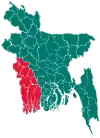Mongla
মোংলা | |
|---|---|
_(16588366034).jpg.webp) Boats in Mongla | |
.svg.png.webp) | |
| Coordinates: 22°29′N 89°36.5′E / 22.483°N 89.6083°E | |
| Country | |
| Division | Khulna |
| District | Bagerhat |
| Headquarters | Mongla |
| Area | |
| • Total | 1,461.20 km2 (564.17 sq mi) |
| Population (2011) | |
| • Total | 136,588 |
| • Density | 93/km2 (240/sq mi) |
| Time zone | UTC+6 (BST) |
| Website | Official Map of Mongla |
Mongla (Bengali: মংলা) is an upazila of Bagerhat District in the Division of Khulna, Bangladesh. Its headquarters are the town of Mongla.
Geography
Mongla is located at 22°29′00″N 89°36′30″E / 22.4833°N 89.6083°E. It has 32,383 households and total area 1461.20 km2.
Mongla Upazila borders Rampal Upazila on the north, the Bay of Bengal on the south, Morrelganj and Sarankhola Upazilas on the east and Dacope Upazila on the west. The main rivers are Pasur and Mongla.
Mongla (Town) stands on the river Pashur. It is the second biggest seaport of the country. The area of the town is 17.79 km2.
The Port of Mongla
There is a link port in Khulna city. It is the second-largest and busiest seaport in Bangladesh. It is situated close to the shores of the Bay of Bengal and the Pashur river.
Demographics
As of the 2011 Bangladesh census, Mongla upazila had 32,383 households and a population of 136,588. 23,583 (17.27%) were under 10 years of age. Mongla had an average literacy rate of 57.20%, compared to the national average of 51.8%, and a sex ratio of 911 females per 1000 males. 39,837 (29.17%) of the population lived in urban areas.[1][2]
According to the 1991 Bangladesh census, Mongla had a population of 137,947. Males constituted 54.73% of the population, and females 45.27%. The population aged 18 or over was 77,995. Mongla had an average literacy rate of 42.8% (7+ years), compared to the national average of 32.4% literate.[3]
Mongla municipality was established in 1991. The town has a population of 60561; males 57.27%, females 42.73%). The population density is 2943 people per km2. The literacy rate among the town's people is 53.6%. The town has a Dak bungalow.
71.31% of the population is Muslim, 24.95% are Hindu, and 3.74% follow other beliefs.
Administration
Mongla thana was established in 1976 and was turned into an upazila in 1983.
Mongla Upazila is divided into Mongla Municipality and six union parishads: Burirdanga, Chandpi, Chila, Mithakhali, Suniltala, and Sundarban. The union parishads are subdivided into 32 mauzas and 76 villages.[4]
Mongla Municipality is subdivided into 9 wards and 13 mahallas.[4]
Education
The literacy rate is 42.80%, comprising 49.6% among males, and 34.2% among females. The educational institutions comprise four colleges, 20 high schools, a junior school, 32 government primary schools, 29 non-government primary schools, five satellite schools and 18 madrasas, the most noted of which is St Pauls High School. It was established in 1954 by Italian missionaries. After that, Freedom Fighter Father Marino Rigon dedicated his whole career for this, and he was laid to rest in Mongla too.[5]
According to Banglapedia, Mongla Bandar Secondary School, founded in 1987, is a notable secondary school.[6]
Media
The newspapers and periodicals are the Daily Sundarban and weekly Mongla.
References
- 1 2 "Bangladesh Population and Housing Census 2011 Zila Report – Bagherhat" (PDF). bbs.gov.bd. Bangladesh Bureau of Statistics.
- ↑ "Community Tables: Bagherhat district" (PDF). bbs.gov.bd. Bangladesh Bureau of Statistics. 2011.
- ↑ "Population Census Wing, BBS". Archived from the original on 2005-03-27. Retrieved November 10, 2006.
- 1 2 "District Statistics 2011: Bagerhat" (PDF). Bangladesh Bureau of Statistics. Archived from the original (PDF) on 13 November 2014. Retrieved 14 July 2014.
- ↑ Correspondent, Bagerhat. "Father Marino Rigon laid to rest in Mongla". Retrieved 22 October 2018.
- ↑ Rahman, Moshfequr (2012). "Mongla Upazila". In Islam, Sirajul; Jamal, Ahmed A. (eds.). Banglapedia: National Encyclopedia of Bangladesh (Second ed.). Asiatic Society of Bangladesh.
